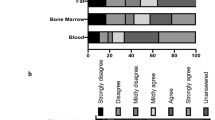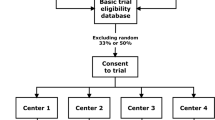Abstract
After three decades of clinical research on interventions to improve neurological outcomes in persons with spinal cord injury (SCI), the promise of preclinical discovery has yet to be translated into a consensus standard of care treatment. Nonetheless, SCI researchers remain hopeful that advances in preclinical discovery coupled with improved clinical trial performance will yield effective restorative treatment. This historical review of key studies in SCI over the past 30 years illustrates the progress that has been achieved in establishing a high standard in the conduct of clinical research while providing important lessons for improving trial design, conduct and reporting. Through application of these lessons, the performance of SCI trials can be improved, thereby shortening the pathway to successful translation and the development of effective therapies.
Similar content being viewed by others
Log in or create a free account to read this content
Gain free access to this article, as well as selected content from this journal and more on nature.com
or
References
Tator CH . Review of treatment trials in human spinal cord injury: issues, difficulties, and recommendations. Neurosurgery 2006; 59: 957–987.
Kwon BK, Sekhorn LH, Fehlings MG . Emerging repair, regeneration, and translational research advances for spinal cord injury. Spine 2010; 35: S263–S270.
Stroke Therapy Academic Industry Roundtable. Recommendations for standards regarding preclinical neuroprotective and restorative drug development. Stroke 1999; 30: 2752–2758.
Fisher M . Recommendations for advancing development of acute stroke therapies: stroke therapy academic industry roundtable 3. Stroke 2003; 34: 1539–1546.
Lammertse D, Tuszynski MH, Steeves JD, Curt A, Fawcett JW, Rask C et al Guidelines for the conduct of clinical trials in spinal cord injury as developed by the ICCP panel: clinical trial design. Spinal Cord 2007; 45: 232–242.
Nesathurai S . Steroids and spinal cord injury: revisiting the NASCIS 2 and NASCIS 3 trials. J Trauma 1998; 45: 1088–1093.
Bracken MB . Steroids for acute spinal cord injury (Cochrane Review). In:. The Cochrane Library, Issue 1 John Wiley & Sons, Ltd.: Chichester, UK. 2004.
American Association of Neurological Surgeons/Congress of Neurological Surgeons. Pharmacological therapy after acute cervical spinal cord injury. Neurosurgery 2002; 50: S63–S72.
Hall ED, Springer JE . Neuroprotection and acute spinal cord injury: a reappraisal. NeuroRx 2004; 1: 80–100.
Bracken MB, Collins WF, Freeman DF, Shepard MJ, Wagner FW, Silten RM et al Efficacy of methylprednisolone in acute spinal cord injury. JAMA 1984; 251: 45–52.
Bracken MB, Shepard MJ, Collins WF, Holford TR, Young W, Baskin DS et al A randomized, controlled trial of methylprednisolone or naloxone in the treatment of acute spinal-cord injury. N Engl J Med 1990; 322: 1405–1411.
Bracken MB, Shepard MJ, Holford TR, Leo-Summers L, Aldrich EF, Fazl M et al Administration of methylprednisolone for 24 or 48 h or tirilazad mesylate for 48 h in the treatment of acute spinal cord injury. JAMA 1997; 277: 1597–1604.
Leary W Treatment is said to reduce disability from spinal injury. The New York Times, 31 March 1990. available at http://www.nytimes.com/1990/03/31/us/treatment-is-said-to-reduce-disability-from-spinal-injury.html.
Coleman WP, Benzel E, Cahill DW, Ducker T, Geisler F, Green B et al A critical appraisal of the reporting of the national acute spinal cord injury studies (II and III) of methylprednisolone in acute spinal cord injury. J Spinal Disord 2000; 13: 185–199.
Hurlbert RJ . Methylprednisolone for acute spinal cord injury: an inappropriate standard of care. J Neurosurg 2000; 93: 1–7.
Otani K, Abe H, Kadoya S, Nakagawa H, Ikata T, Tominaga S et al Beneficial effect of methylprednisolone sodium succinate in the treatment of acute spinal cord injury (in Japanese). [Sekitsui Sekizui] 1994; 7: 633–647.
Pointillart V, Petitjean ME, Wiart L, Vital JM, Ticoipe M, Dabadie P . Pharmacological therapy of spinal cord injury during the acute phase. Spinal Cord 2000; 38: 71–76.
Galandiuk S, Raque G, Appel S, Polk HC . The two-edged sword of large-dose steroids for spinal cord trauma. Ann Surg 1993; 218: 419–427.
Gerndt SJ, Rodriguez JL, Pawlik JW, Taheri PA, Wahl WL, Michaels AJ et al Consequences of high-dose steroid therapy for acute spinal cord injury. J Trauma 1997; 42: 279–284.
Matsumoto T, Tamaki T, Kawakami M, Yoshida M, Ando M, Yamada H . Early complications of high-dose methylprednisolone sodium succinate treatment in the follow-up of acute cervical spinal cord injury. Spine 2001; 26: 426–430.
Qian T, Guo X, Levi AD, Vanni S, Sherbert RT, Sipski ML . High-dose methylprednisolone may cause myopathy in acute spinal cord injury patients. Spinal Cord 2005; 43: 199–203.
Bracken MB, Shepard MJ, Holford TR, Leo-Summers L, Aldrich EF, Fazl M et al Methylprednisolone or tirilazad mesylate administration after acute spinal cord injury: 1-year follow up. J Neurosurg 1998; 89: 699–706.
Committee on Trauma, American College of Surgeons. Spine and spinal cord trauma In:. Advanced Trauma Life Support Student Course Manual. American College of Surgeons: Chicago. 2008 p 170.
Liu JC, Patel A, Vaccaro AR, Lammertse DP . Methylprednisolone after traumatic spinal cord injury: yes or no? PMR 2009; 1: 669–673.
Geisler FH, Dorsey FC, Coleman WP . Recovery of motor function after spinal-cord injury—a randomized, placebo-controlled trial with GM-1 ganglioside. N Engl J Med 1991; 324: 1829–1838.
Geisler FH, Coleman WP, Grieco G, Poonian D . The Sygen multicenter acute spinal injury study. Spine 2001; 26: S87–S98.
Harrop JS, Maltenfort MG, Geisler FH, Coleman W, Jones LAT, Wirth E et al Traumatic thoracic ASIA A examinations and potential for clinical trials. Spine 2009; 34: 2525–2529.
Fawcett JW, Curt A, Steeves JD, Coleman WP, Tuszynski MH, Lammertse D et al Guidelines for the conduct of clinical trials in spinal cord injury as developed by the ICCP panel: spontaneous recovery after spinal cord injury and statistical power needed for therapeutic clinical trials. Spinal Cord 2007; 45: 190–205.
Steeves JD, Kramer JK, Fawcett JW, Cragg J, Lammertse DP, Blight AR et al Extent of spontaneous motor recovery after traumatic cervical sensorimotor complete spinal cord injury. Spinal Cord 2011; 49: 257–265.
Hansebout RR, Blight AR, Fawcett S, Reddy K . 4-aminopyridine in chronic spinal cord injury: a controlled, double-blind, crossover study in eight patients. J Neurotrauma 1993; 10: 1–18.
Hayes KC, Potter PJ, Wolfe DL, Hsieh JTC, Delaney GA, Blight AR . 4-aminopyridine-sensitive neurologic deficits in patients with spinal cord injury. J Neurotrauma 1994; 11: 433–446.
Cardenas DD, Ditunno J, Graziani V, Jackson AB, Lammertse D, Potter P et al Phase 2 trial of sustained-release fampridine in chronic spinal cord injury. Spinal Cord 2007; 45: 158–168.
Knoller N, Auerbach G, Fulga V, Zelig G, Attias J, Bakimer R et al Clinical experience using incubated autologous macrophages as a treatment for complete spinal cord injury: phase I study results. J Neurosurg Spine 2005; 3: 173–181.
Jones LAT, Lammertse DP, Charlifue SB, Kirshblum SC, Apple DF, Ragnarsson KT et al A phase 2 autologous cellular therapy in patients with acute, complete spinal cord injury: pragmatics, recruitment, and demographics. Spinal Cord 2010; 48: 798–807.
Lammertse DP, Jones LAT, Charlifue SB, Kirshblum SC, Apple DF, Ragnarsson K et al Autologous incubated macrophage therapy in acute, complete spinal cord injury: results of the Phase 2 randomized controlled multicenter trial. Spinal Cord 2012; 50: 661–671.
Rossignol S, Chau C, Brustein E, Belanger M, Barbeau H, Trevor D . Locomotor capacities after complete and partial lesions of the spinal cord. Acta Neurobiol Exp 1996; 56: 449–463.
Wernig A, Muller S . Laufband locomotion with body weight support improved walking in persons with severe spinal cord injuries. Paraplegia 1992; 30: 229–238.
Behrman AL, Harkema SJ . Locomotor training after human spinal cord injury: a series of case studies. Phys Ther 2000; 80: 688–700.
Dobkin BH, Apple D, Barbeau H, Basso M, Berhman A, Deforge D et al Weight-supported treadmill vs over-ground training for walking after acute incomplete SCI. Neurology 2006; 66: 484–493.
Wolpaw J . Treadmill training after spinal cord injury: good but not better. Neurology 2006; 66: 466–467.
Wernig A . Weight-supported treadmill vs over-ground training for walking after acute incomplete SCI. Neurology 2006; 67: 1900.
Barbeau H, Basso M, Behrman A, Harkema S . Treadmill training after spinal cord injury: good but not better. Neurology 2006; 67: 1900–1901.
Dobkin BH, Duncan PW . Should body weight-supported treadmill training and robotic-assistive steppers for locomotor training trot back to the starting gate? Neurorehabil Neural Repair 2012; 26: 308–317.
Blight A, Curt A, Ditunno JF, Dobkin B, Ellaway P, Fawcett J et al Position statement on the sale of unproven cellular therapies for spinal cord injury. Spinal Cord 2009; 47: 713–714.
Curt A . The translational dialogue in spinal cord injury research. Spinal Cord 2012; 50: 352–357.
Schulz KF, Altman DG, Moher D . CONSORT 2010 statement: updated guidelines for reporting parallel group randomized trials. Ann Intern Med 2010; 152: 1–7.
Dobkin BH . What matters in cellular transplantation for spinal cord injury: the cells, the rehabilitation, or the best mix? Neurorehabil Neural Repair 2010; 24: 7–9.
Author information
Authors and Affiliations
Corresponding author
Rights and permissions
About this article
Cite this article
Lammertse, D. Clinical trials in spinal cord injury: lessons learned on the path to translation. The 2011 International Spinal Cord Society Sir Ludwig Guttmann Lecture. Spinal Cord 51, 2–9 (2013). https://doi.org/10.1038/sc.2012.137
Received:
Revised:
Accepted:
Published:
Issue date:
DOI: https://doi.org/10.1038/sc.2012.137
Keywords
This article is cited by
-
Promoting FAIR Data Through Community-driven Agile Design: the Open Data Commons for Spinal Cord Injury (odc-sci.org)
Neuroinformatics (2022)
-
Protective Effects of Estrogen via Nanoparticle Delivery to Attenuate Myelin Loss and Neuronal Death after Spinal Cord Injury
Neurochemical Research (2021)
-
Adaptive trial designs for spinal cord injury clinical trials directed to the central nervous system
Spinal Cord (2020)
-
Transcriptomics uncovers substantial variability associated with alterations in manufacturing processes of macrophage cell therapy products
Scientific Reports (2020)
-
Physiotherapy interventions for increasing muscle strength in people with spinal cord injuries: a systematic review
Spinal Cord (2019)



